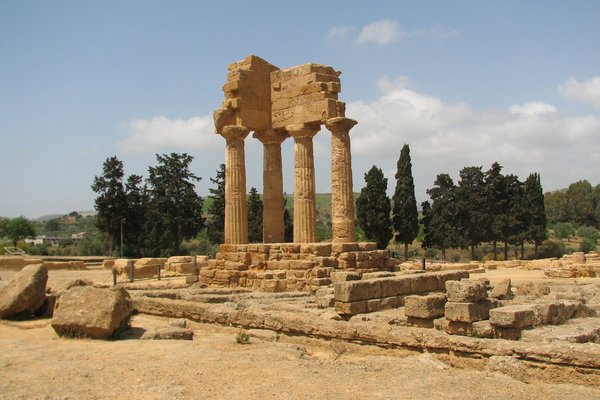Italy
Agrigento
The Archaeological Area of Agrigento is known for its Greek architecture.
The site is a testament to a Greek colony that flourished here from the 6th century BCE. It comprises the remains of the acropolis and the sacred hill. The latter was adorned by numerous magnificent Doric temples, which have been preserved in good condition.
Community Perspective: The temple of Concordia is the undoubted highlight. Be aware that this so-called ‘Valley of the Temples’ requires a non-trivial amount of walking.
Site Info
Official Information
- Full Name
- Archaeological Area of Agrigento (ID: 831)
- Country
- Italy
- Status
-
Inscribed 1997
Site history
History of Agrigento
- 1997: Inscribed
- Inscribed
- Type
- Cultural
- Criteria
- i
- ii
- iii
- iv
Links
- UNESCO
- whc.unesco.org
- Official
-
- parcovalledeitempli.it — Site of Park of the Valley of the Temples
- Related
-
- livius.org — Acragas - by Livius, Articles on Ancient History
All Links
UNESCO.org
- whc.unesco.org — whc.unesco.org/
Official Website
- parcovalledeitempli.it — Site of Park of the Valley of the Temples
Related Resources
- livius.org — Acragas - by Livius, Articles on Ancient History
News Article
- March 1, 2024 theguardian.com — Long-buried Atlas statue raised to guard Temple of Zeus in Sicily once more
- Aug. 11, 2023 arkeonews.net — Rich Votive Deposit Discovered in the Valley of the Temples of Agrigento
- Dec. 2, 2015 news.discovery.com — Ancient Greek Temple Aligned to Full Moon
- July 25, 2015 dailymail.co.uk — Google hires Valley of the Temples in Sicily to host a £70,000 banquet for top executives
- Nov. 21, 2008 independent.co.uk — Italian government plans to build a huge liquid gas terminal less than a mile away from the famous Agrigento site
Community Information
- Community Category
- Archaeological site: Ancient Greece
Travel Information
Sicily hotspot
Recent Connections
-
Perfect Inscriptions
1997 -
Alexandre Dumas
Dumas recounts his visit to Sicily in h… -
Located in a TCC Territory
Sicily
Connections of Agrigento
- Individual People
-
-
Goethe
"(...) Goethe, in whose "Italiänische Reise" the most moving pages are devoted to the natural and artistic beauties of Agrigento." (AB Ev) - Johann Wolfgang von Goethe describes his visit to the site in his work "Italian Journey".See de.wikipedia.org
-
Alexandre Dumas
Dumas recounts his visit to Sicily in his work "Le Speronare", during which he visited Catania, Syracuse, the Valley of the Temples in Agrigento and ascended the Etna.See fr.wikipedia.org
-
- Geography
- Trivia
-
-
Depicted in Mizielinska Maps
Temple of ConcordiaSee i.pinimg.com
-
- History
-
-
Ancient Greek colonies
-
Sieges and Battles
Romans 261BC -
Hellenistic Greece
Selected excavated areas reveal the late Hellenistic and Roman town (OUV) -
Byzantine Empire and Civilization
"After the fall of the Western Roman Empire, the city successively passed into the hands of the Vandalic Kingdom, the Ostrogothic Kingdom of Italy and then the Byzantine Empire."See en.wikipedia.org
-
Classical Greece
The Temple of Concord "was erected at the height of the Classical age (440-430 BC)." (Santoro, Rodo, "Agrigento - The Valley of the Temples") -
Normans
From the 7th century, Agrigento was in decline and was successively occupied by the Arabs and then by the Normans in 1086, who called it Girgenti. (AB Ev) -
Punic Empire
"A democratic regime was established in the later 5th century BC (...). This came to a brutal end in 406 BC, when it was besieged and sacked by the Carthaginians. It struggled to regain its former glory, and succeeded briefly under Timoleon, who crushed the Carthaginians in 340 BC and brought in new colonists." (AB Ev) "The city was disputed between the Romans and the Carthaginians during the First Punic War. The Romans laid siege to the city in 262 BC and captured it after defeating a Carthaginian relief force in 261 BC and sold the population into slavery. Although the Carthaginians recaptured the city in 255 BC the final peace settlement gave Punic Sicily and with it Akragas to Rome."See en.wikipedia.org
-
- Architecture
-
-
Restored by anastylosis
(Temple of Heracles) -
Mosaic art
"(...) there are substantial excavated areas of the residential area of Hellenistic and Roman Agrigento. A number of the houses have well preserved mosaic pavements." (AB Ev)
-
- Damaged
-
-
Destroyed or damaged by Earthquake
"The other temples" (apart from those of Hera Lacinia and Concordia) "are much more fragmentary, having been toppled by earthquakes long ago and quarried for their stones."See en.wikipedia.org
-
- World Heritage Process
-
-
Perfect Inscriptions
1997 -
WHC locations
Naples (1997) -
Reconstruction regarded as unsatisfactory
"It must be recognized, of course, that some restoration work carried out in the late 18th and 19th centuries in no way conforms with the principles of modem conservation, as set out in the 1964 Venice Charter. The restored pediment of the Temple of the Dioscuri is an example of inaccurate reconstruction that did not operate on the basis of rigorous anastylosis." (AB Ev)
-
- Religion and Belief
-
-
Cistercian
The Archaeological Museum was partly built on the remains of the walls of a 13th-century Cistercian monastery. The so-called Oratory of the Phalaris dates from the 2nd century BC and is the only cult building in Agrigentum that was newly erected during Roman times. In the Middle Ages it was integrated into the Cistercian monastery as an oratory.See de.wikipedia.org
-
Hercules
Temple of Heracles/HerculesSee en.wikipedia.org
-
- Constructions
-
-
Necropolises
"The site boundary includes the entire territory of the ancient polis, including the extramural area of the necropolis (...)" (Official description) – "At the western tip of the area in which the Temple of Concordia lies, are parts of a late-ancient or early-medieval necropolis, constructed on existing cisterns. (...) These late-Roman and Byzantine necropolises lie in an area used for tombs since ancient times."See en.wikipedia.org
-
Aqueduct
"The site boundary includes (...) the complex network of underground aqueducts" (Official description) - Northwest of the sanctuary of the chthonic deities, a valley cuts through the southern range of hills. It is assumed that the large water basin known as Kolymbéthra, which served to supply the city with water, was also located here. After the basin silted up, fertile orchards and vegetable gardens emerged, the Gardens of Kolymbéthra. The underground water channels and aqueducts that supplied water to the city in ancient times can still be seen today and are now used to irrigate the gardens.See de.wikipedia.org
-
Bouleuterion
The Bouleuterion was found in 1989 during excavations north of the Archaeological Museum.See de.wikipedia.org
-
Catacombs
"The area around the Temple of Concordia was later re-used by early Christians as a catacomb, with tombs hewn out of the rocky cliffs and outcrops."See en.wikipedia.org
-
Cisterns
A cistern was found near the rear (west side) of the Temple of Hera/Juno.See de.wikipedia.org
-
Asklepieion
"The Temple of Asclepius is located in the middle of the San Gregorio plain."See en.wikipedia.org
-
Unfinished constructions
Temple of Olympian Zeus, "The roof was probably never completed, though the pediments had a full complement of marble sculptures"See en.wikipedia.org
-
- WHS on Other Lists
-
-
INTO Places Program
Giardino della KolymbethraSee fondoambiente.it
-
Located in a TCC Territory
Sicily
-
- Timeline
-
-
Built in the 5th century BC
great temples were built during the rule of the tyrant Thero (488-473 BC)
-
- WHS Hotspots
-
-
Sicily hotspot
Sicily hotspot
-
- Science and Technology
-
-
Archaeological potential
"The site boundary includes (...) a wide portion of land where there are still unexcavated archaeological structures." (Official description)
-
News
- theguardian.com 03/01/2024
- Long-buried Atlas statue raised to…
- arkeonews.net 08/11/2023
- Rich Votive Deposit Discovered in …
- news.discovery.com 12/02/2015
- Ancient Greek Temple Aligned to Fu…
Recent Visitors
Visitors of Agrigento
- Afshin Iranpour
- Alexander Barabanov
- Alexander Lehmann
- Alikander99
- ALS
- Ammon Watkins
- Ana Lozano
- Argo
- Artur Anuszewski
- Aspasia
- Atila Ege
- Badwater
- BaziFettehenne
- Bill Maurmann
- Bin
- Birgitte Sørensen
- bossc
- Bram de Bruin
- Brendan Carroll
- Bropyk
- butterflybird
- Caspar
- Cezar Grozavu
- chenqtao
- ChrisN
- Christian Wagner
- Claire Bradshaw
- Clyde
- Col
- Cristina Erba
- Csaba Nováczky
- CugelVance
- Dagmara
- Daniela Hohmann
- Daniel Chazad
- Dan Pettigrew
- David Berlanda
- Dimitar Krastev
- Dimitrios Polychronopoulos
- DouglasR
- Dr. Caligari
- Echwel
- eljx1988
- Els Slots
- Emilia
- Emili Xaus
- Erfe91
- Erik Jelinek
- Eva Kisgyorgy
- Evgenii
- Fan Yibo
- Farinelli
- Fede1203
- fedemarch92
- Federico P.
- Feldhase
- Felicité
- Femke Roos
- Filip Murlak
- Flexiear
- Fmaiolo@yahoo.com
- FS
- Gabbro
- Geert Luiken
- George Gdanski
- GeorgeIng61
- giulio25
- grimloch
- Grzegorz Andruszkiewicz
- Hadrianus
- Hammeel
- Harry Mitsidis
- H Beswick
- Hdhuntphotography
- Hubert
- Iain Jackson
- Ilya Burlak
- Ivan
- Ivan Rucek
- Jakob F.
- Jakubmarin
- Jana and Matt
- janem
- Janina Lehmann
- Jarek Pokrzywnicki
- Jasam
- Jeanne OGrady
- Jens
- Jezza
- João Aender
- Joel on the Road
- Jonas Kremer
- JR's HERITAGE SITES
- Juha Sjoeblom
- Jurre
- KarenBMoore
- Kasper
- KeithBailey
- Ken DJ
- KentishTownRocks
- Krijn
- kristinapunzi
- Krzysztof B
- Lado Joel
- Lara Adler
- Liamps91
- Lisu Marian
- Liverpool
- Loic Pedras
- Luboang
- Lucas Del Puppo
- Lucio
- Ludvan
- Luis Filipe Gaspar
- Lukasz Palczewski
- Maciej Gil
- Maciej Gowin
- Malgorzata Kopczynska
- Manuelfunk
- marc Rouserez
- Martin
- Martina Rúčková
- Matejicek
- Matthewsharris
- MAURO PODDA PANI
- MaxHeAnouBen
- MaYumin
- MH
- MichaelH
- Michael Novins
- Mikko
- Mikko Syrjä
- Milan Jirasek
- Ming_9734
- Monica Tasciotti
- nan
- Nasebaer
- Niall Sclater
- Nihal Ege
- opperpco3
- PabloNorte
- Patrik
- Paul Schofield
- PeterH
- Peter Lööv
- Philipp Leu
- Philipp Peterer
- phillipmeng
- Pierre T
- Pieter Dijkshoorn
- Pink Bunny
- Piotr Wasil
- preunesco
- Priyaranjan Mohapatra
- puessergio
- Purrfect
- Rafał Kałczuga
- Rahelka
- Ralf Regele
- Randi Thomsen
- reddargon
- Remigiusz
- Reza
- Riccardo Quaranta
- Rick Ohm
- RobRos
- Roccobot
- Rodinia
- Roel Sterken
- Roger Ourset
- Roman Bruehwiler
- Sabrina Liebehentschel
- Samato
- Samy G
- Sandmann15
- Schnitzel
- Sergio Arjona
- Shandos Cleaver
- SirLoydd
- Slavi
- Solivagant
- Ssong.x
- Stanislaw Warwas
- stephanvermeulen
- Stijn
- Sutul
- Svein Elias
- Szabolcs Mosonyi
- Szabo Viktoria
- Szucs Tamas
- Taotao Chen
- Tarquinio_Superbo
- Tatiana Nikulnikova
- Tevity
- thisispivi
- Thomas Buechler
- Thomas van der Walt
- Tim Allen
- Timothy C Easton
- Tom Flaten
- tony0001
- triath
- Tsunami
- Twobaconsandaboston
- usagi1974
- Valentina
- ValiaVeweth
- Vanessa Buechler
- Van Hung
- Viaje al Patrimonio
- vino4vino
- V&M
- Waxwing
- Wojciech Fedoruk
- Xander Huang
- Xiquinho Silva
- yasdeb
- Yevhen Ivanovych
- Yongcheng Liu
- Zizmondka
- Zoë Sheng
- Zsuzsanna Forray
Community Reviews
Show full reviews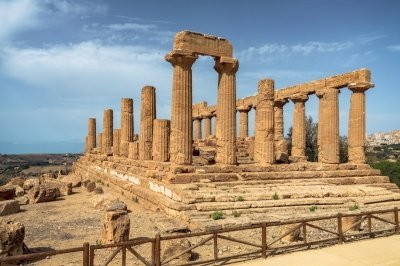
I visited the archaeological area of Agrigento, officially known as “Valley of the Temples”, in September of 2021. This is, in essence, a collection of stand-alone highlights, of which the main one - Temple of Concordia - is a good reason to visit all by itself, being clearly among the best-preserved Doric temples anywhere.
The second-best preserved temple, Juno, still has around 30 columns standing, and in the usual context of antiquity should be considered as amazingly well-surviving. Nonetheless, here you are well into the archaeological realm of having to imagine what the place might have looked like in its heyday rather than actually seeing it.
Another major sight, Temple of Hercules, is a picturesque file of several columns among huge rocks. Other temples – Zeus, Hefestos, Castor and Pollux – remain mostly as a memory; a single portal among the piles of stones. Also within the confines of the area, there is a villa with gardens that once belonged to a British nobleman and archaeologist and then assorted burial sites here or there - all of limited interest to a non-archaeologist but not without occasional visual quality.
Valley of the Temples is quite large, with a non-trivial amount of walking required between the aforementioned main points of interest. We covered about two-thirds of it on our visit, the distance of about a mile between the Temple of Juno and the Temple of Zeus. The main parking lots happen to be in the vicinity of those two …
Keep reading 0 comments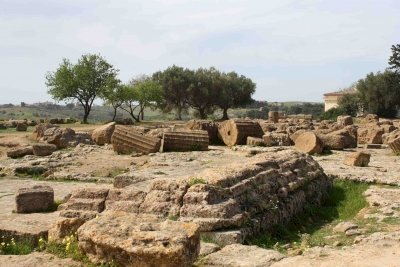
March 2019 - on our 6th day we arrived in Agrigento. The city was flooded with people and traffic. There was no way to access the Val di Tiempi. Very unfortunate, since there was Sagra del Mandorlo in Fiore. A festival dedicated for blooming almond trees with dances and food. We are a bit sad, that we missed this event.
Next day however, we visited the archaelogical park. You pay 10€ entrance and can take a walk along the temples. They are located on a geological fold and if you look into the right direction, you find many nice motivves for photography. If you look in the direction of Agrigento, you see eyesores of buildings from the 60s, destroying the authenticity and ruining the cultural landscape. We had a nice few hours in the park, before we continued our journey back into the islands interior.
Keep reading 0 comments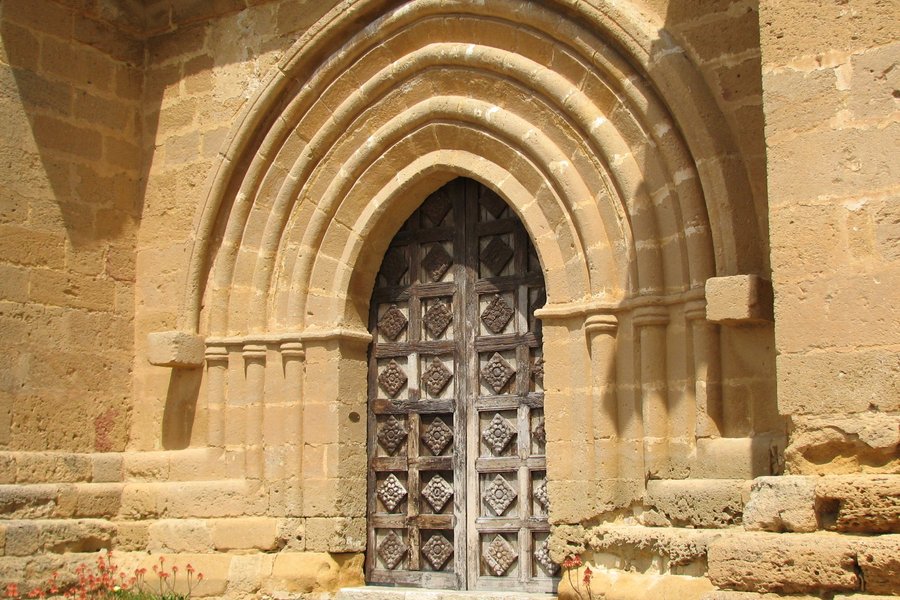
We visited the valley, which is actually a hill, in June 2014. It was a very hot and sunny day so mrs Ech Wel was begging her travel-agent all the time when we would finally go to the beach. She isn´t really into ancient ruins and prefers a tan.
There are 7 temples on site of which the one named Concordia is the best preserved. It was named after a Latin text found near the temple which was talking about harmony among humans. (Concordia is the latin word for unity and concord.) It was kind of appropriate as this was our honeymoon.
Even more suiting was our visit to the temple of Hera, the goddess of marriage and weather conditions! It is an old custom for young couples to visit the sacred building to quarantee a successfull wedding. We paid our homage of course and called it a day. Off we were to the nearby beach of Eraclea Minoa.
Of course when we arrived at the coast the sky had turned from blue to grey. It was full of clouds instead off the deep blue heaven it was just a few minutes before. We waited for a while to give it a chance to get better again but had no such luck. When we drove home we soon found out that it was our own fault...
Our appartment was at the foot of the Etna vulcano and as we came in her neighborhood we discovered that the clouds we had …
Keep reading 0 comments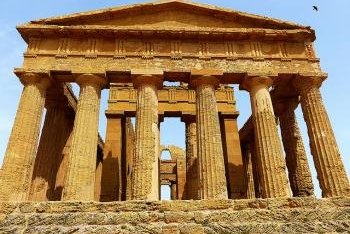
I visited this WHS in May 2015. I had been wanting to visit this site but I wanted the reconstruction work to be ready before visiting. My patience was rewarded and the yellowish remains of Magna Grecia stood as might as ever on a sunny afternoon when I visited. As I was visiting by car, I decided to park in the car park which was farthest from the Temple of Concordia. Then I took a convenient taxi ride costing 3 euros per person to the opposite side of the archaeological park and walked downhill visiting the 5 most important temples of Agrigento one after the other. The garigue setting around the temples (olive trees, Mediterranean shrubs, prickly pears and pine trees makes you forget the urban sprawl of the New Agrigento in the not so distant background and I enjoyed unforgettable moments of tranquillity during which I had the temples all to myself. In Summer tourist groups are known to flock by the thousands here but I was quite lucky during my visit. The museum is worth visiting too even though the ticket price is quite steep. My visit ended just next to the car park so the 3 euros taxi ride was well worth it. Although I visited several other Greek temples/remains in Sicily, the Valley of the Temples is by far the most complete and the most outstanding and having visited the Acropolis in Greece last year, I can safely say that the overall experience in Agrigento matches …
Keep reading 0 comments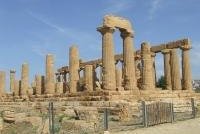
Catching an early bus outside Agrigento station I reached the Valley of the Temples just as the gates opened. This enabled me to make a tour of the temples of Concord, Juno and Hercules before the crowds arrived. Equally interesting to me though were the 19th centuary bronze statues scattered amongst the ancient Greek ruins.
Keep reading 0 comments
No visit to Sicily is complete without a visit to Agrigento. The temple of Concordia is one of the most completely preserved Greek temples to be found anywhere. (Its preservation is due to its being turned into a church.) Just to see it alone is worth the trip. At night it is lit by floodlights and makes a marvelous sight. Besides this temple there is much more Greek history to be seen here. There are several ruined temples and a sacred spring site. Nearby the spring is a temple made into a Byzantine church with a rare well preserverd temple altar. The ruins of probably the largest Greek temple ever attempted is in Agrigento. It had human figures as supporting columns which I think is unique in Greek temples. You can see one of these lying on the ground. Besides Greek remains there are some interesting grave excavations and an area of the Roman city exposed. I was lucky to visit in May when the whole area is ablaze with beautiful wildflowers.
Keep reading 0 comments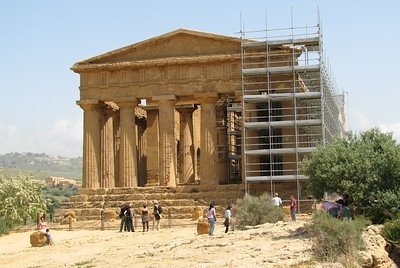
Driving in Sicily for sure is different on a working day: it took me 3 hours to get from Noto to Agrigento, about 150 km. First, there were the hills around Ragusa, which steepness proved too much for the loaded trucks. And then came the rather hellish outskirts of Gela (an even earlier Greek settlement than Agrigento, how times have changed!), where every car just seemed to want to park on the other side of the street and where your eyes are blinded by a forest of screaming billboards. All this made me arrive in Agrigento around 11.30, not the best of times because of the sun and the scores of tour buses.
I started my sightseeing at the top, at the archeological museum. The museum is pleasant enough but specializes in vases a bit too much to my taste. The large Atlas statue however is definitely worth a look.
The ruins are situated downhill and split into two parts by a busy road. The best-preserved temple is the Temple of Concord, partly under scaffolding nowadays. The rest of the large grounds are scattered with stones, some forming sacrificial altars large enough to slaughter 100 oxen at one time.
All in all, I was a bit disappointed with Agrigento. Having seen already quite a number of Greek archeological remains, one gets a bit spoiled and these certainly aren't the best ones for a superficial visit. The site is applauded by ICOMOS as an authentic example of Greek …
Keep reading 0 comments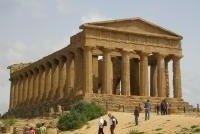
There are many places in Sicily where you feel like you've somehow ended up in Greece; Agrigento is one of those places. The valley complex has several well-preserved temples and the ruins of others that were among the biggest ever built, but I couldn't help but be somewhat disappointed. I was more impressed by the temples and acropolis of Selinunte (just up the coast to the west)which gave a much better insight into life in a 5th century BC Greek colony. Still, Agrigento is a very important archaeological site and well worth a visit for the day. I highly recommend the drive from Palermo; some of the landscape is just gorgeous.
Keep reading 0 comments
